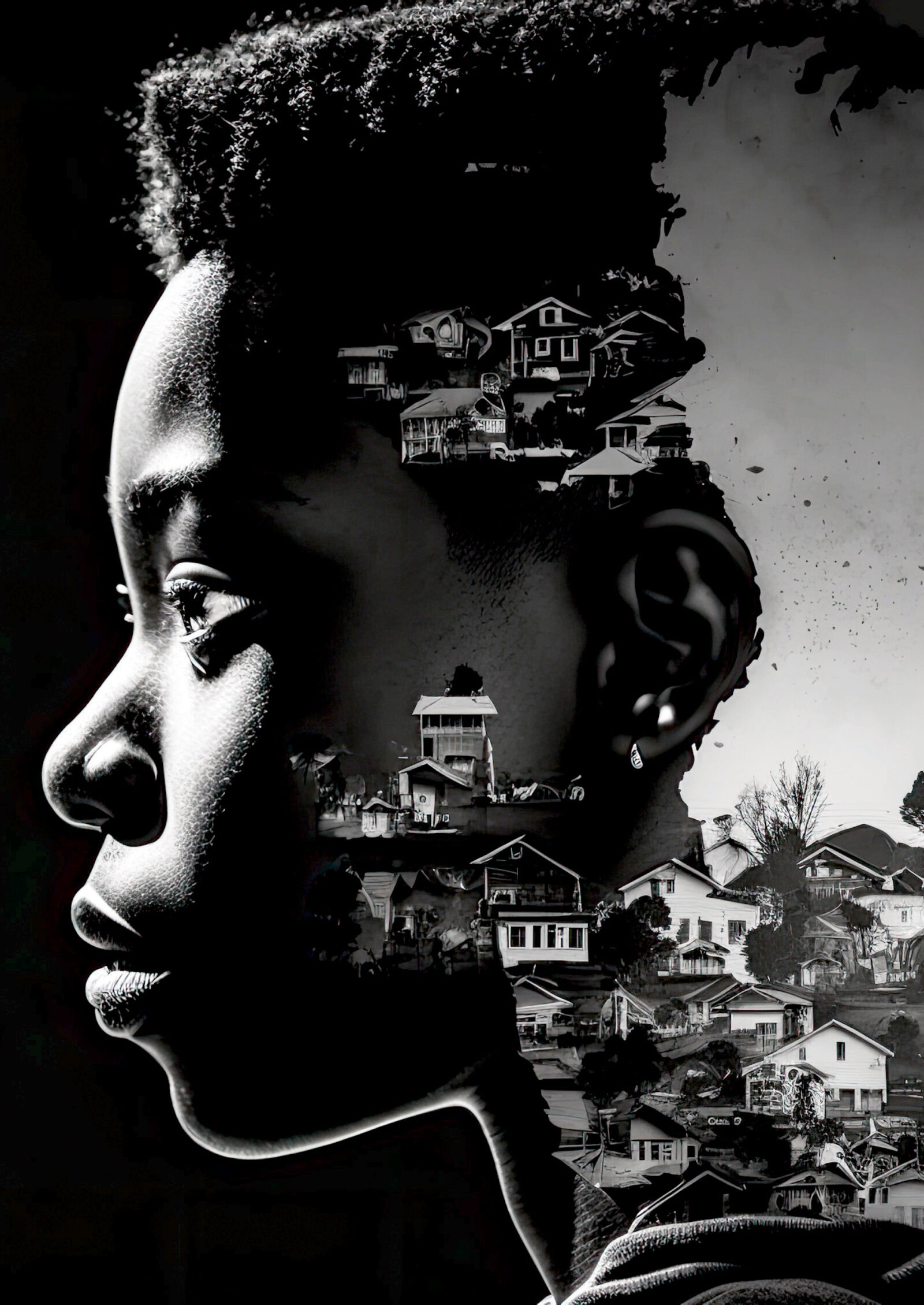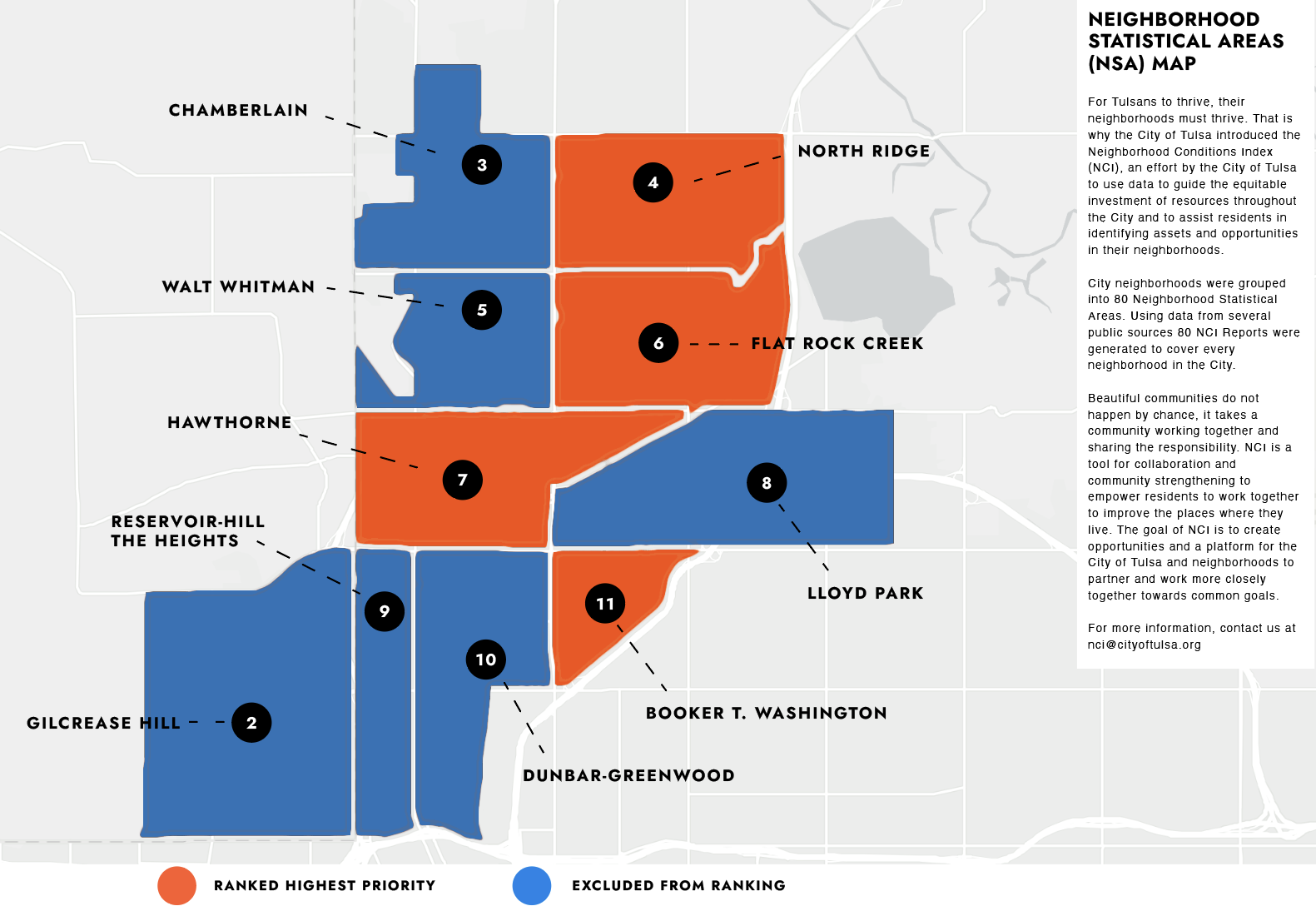
LOCAL & STATE
John Neal
The Oklahoma Eagle
Illustration The Oklahoma Eagle
The new rating system, dubbed the Neighborhood Conditions Index, ranks all north Tulsa in the highest priority except for six predominantly African American neighborhoods – all of which are located in the greater Greenwood residential area.
The city identifies the omitted neighborhoods by name and geographic index numbers as: Gilcrease Hills #2, Chamberlain #3, Walt Whitman #5, Lloyd Park #8, Reservoir Hills/The Heights #9, and Dunbar-Greenwood #10.
North Tulsa advocates familiar with these neighborhoods point out that many of them have had basic needs such as new streetlights and sidewalk repair that the City of Tulsa has not addressed for years.

Yet, a City Planning Department spokesperson told The Oklahoma Eagle that other Tulsa neighborhoods outranked the six Black neighborhoods that were passed over based on the new criteria the city has created.
The new scoring system has 70 “data points” and nine “categories” for measuring neighborhood conditions. The planning tool evaluated 80 distinct Neighborhood Statistical Areas. It designated 20 of the 80 as deserving the “#1 priority” for “equitable distribution of city resources,” according to the City’s Principal Planner, Paulina Baeza, in interviews with The Oklahoma Eagle. They include the following: #33 Garden City, #42 Metcalfe-Magic Circle, and #44 Tower Heights.
Some other neighborhoods designated as requiring top attention are #4 North Ridge, #7 Hawthorne, and #11 Booker T. Washington. Each of the three are predominantly Black.
The six Black neighborhoods omitted from the top priority are clustered with other Greenwood residential areas, all north of I-244 and west of U.S. 75.
These six communities have a population of 23,679, according to the city planning report, making up two-thirds of the population in the 10 predominantly Black neighborhoods in north Tulsa. The city did not carve out the larger Greenwood residential area for independent analysis. But The Oklahoma Eagle grouped them together for comparison because they are contiguous, majority African American, and had similar scores in critical areas of the City’s scoring system.
The 10 neighborhoods are 67% African American. Because of their omission in the top category, the six will be pooled at most in the next 50% of the city neighborhoods requiring resources, according to the Planning Department report.
The Black neighborhoods cluster are #2 through #11 in north Tulsa (see map). The city uses a scale of 0-5 to rate neighborhoods on data points, categories, and overall scores, with lower scores having worse neighborhood conditions. The lowest scoring, 25% of the neighborhoods, are earmarked by the report as priority #1 for city resource assistance.
Scoring the conditions
The 10 majority Black neighborhoods, including the six omitted from the highest priority designation, all have challenging economic, housing, and neighborhood conditions, according to the City’s “data points.” In the category of “Economic Development,” the greater Greenwood neighborhoods all scored very low, many of them in the bottom 10%, and two communities had a .1 rating. Lower scores should be given a higher resource priority according to the scoring scheme. The scores in the Economic Development category for the Black neighborhoods were bogged down principally by stagnant population growth, poor employment opportunities, low household income, and greater poverty.
The Black neighborhoods in north Tulsa also fared poorly and thus demonstrated the greatest need in the “Housing and Neighborhood” category. The greater Greenwood residential cluster again fell to the bottom 25% (worse off) compared to the City’s other neighborhood evaluations.
The city’s analysis for the cluster of Black neighborhoods reflected a disproportionate number of vacant housing units, greater exposure to crime, and cost-burdened renters as well as homeowners. The term “cost-burdened,” as defined by the report, includes all renters or owners spending 30% or more of their household income on housing costs.
The Oklahoma Eagle staff discussed one of the six Black neighborhoods left out of the top priority with city planner Baeza to gain insight into the possible cause that they were not included.
The Chamberlain neighborhood, located in the northwest sector of north Tulsa, was one example discussed. This neighborhood had 34 data point scores in the bottom 25% of all Tulsa neighborhoods. In contrast, Chamberlain had only eight in the top 25%, with all other data point scores in neither extreme. Even the eight data points where the neighborhood scored high were less critical to neighborhood’s well-being.
After conferring with a city neighborhood scoring analyst, Baeza confirmed that several score unidentified data points were “weighted” more than others. Additionally, Chamberlain’s higher scores on the data points were for fewer auto-related collisions, more “environmental and natural resources,” and greater access to trails, none of which seem crucial. The “Bottom Category Scores,” which should translate into a higher priority for Chamberlain, were in the vital categories of Economic Development, Housing and Neighborhoods, and Land Use.
Undisclosed weighted scores
The scoring system report provides data points in categories comparing neighborhood conditions to the rest of Tulsa’s neighborhoods. But the report adds the “category scores are not an average of the associated data points” because some data points are given additional weight “as priorities in the comprehensive plan.” These weighted data points are not revealed in the report.
Baeza told The Oklahoma Eagle, “[The] Overall Score is based on all the weighted data points under the nine categories.” This phenomenon could explain how six Black neighborhoods, all having poor neighborhood conditions, failed to achieve a priority ranking for city resources.
Additionally, Tulsa’s Principal Planner Baeza provided The Oklahoma Eagle with this written comment on the issue, “The data was selected, analyzed, and scored based on a process that included research, our interpretation of its relevance in each chapter of the comprehensive plan, and discussions with subject matter experts and City departments. I do not recall the specific weights by data points and category.”
Social justice scoring
To balance the overall scoring, the city adds what Baeza calls a “social justice” component to the final grade to determine which neighborhoods will have the highest priority in the final scoring evaluation. The written report describes this as “selected equity data from the Area Snapshot.” The Snapshot summarizes “Demographics, Economy, Public Services and Neighborhood Groups” for each Neighborhood Statistical Area. However, only items “marked with an asterisk (*) were used to calculate the Overall Score,” the report reads.
Apart from extra credit for neighborhood groups, the neighborhood may receive credit not for conditions in the neighborhood but for the demographic characteristics of its residents. These include credit for populations under 18 or over 65, low-income or single-parent households, less than high school-educated persons, and “Race, Ethnicity [non-white] & Ability” characteristics. These are measured against the City of Tulsa averages.
The report does not disclose the weighting of the social justice data points. But Baeza told The Oklahoma Eagle in an email, “50% of the Overall Score refers to selected equity data [asterisked items], and each data point was given an equal weight.” The snapshots for the six predominately Black neighborhoods in north Tulsa, which are omitted from priority ranking, would suggest additional credit may have been due.
Here are the averages for the six compared to Tulsa for some key asterisked items, which The Oklahoma Eagle compiled from the city’s snapshot reports. In this case, the scoring scheme should provide higher-scoring neighborhoods weighted credit for a priority rating in “social justice.” That component is 50% of the overall score for the neighborhoods.

Senior Planner Paulina Baeza emphasized to The Oklahoma Eagle that this was the city’s first attempt at a comprehensive neighborhood condition rating scheme and that the Planning Department was hopeful for input from the public and neighborhood leaders. Baeza added, “This is a living document, and this is our first set of reports to be released.”
When considering “social justice,” City of Tulsa officials may need to be reminded to include in their thinking several key historical events which have had a lasting impact on the conditions in Black neighborhoods in Tulsa. One is the 1921 Tulsa Race Massacre, whose scars shadow the community to this day. Another is the construction of I-244, which splintered the Greenwood District, dislocated residences and businesses, and tore at the economic and social fabric of the community.










